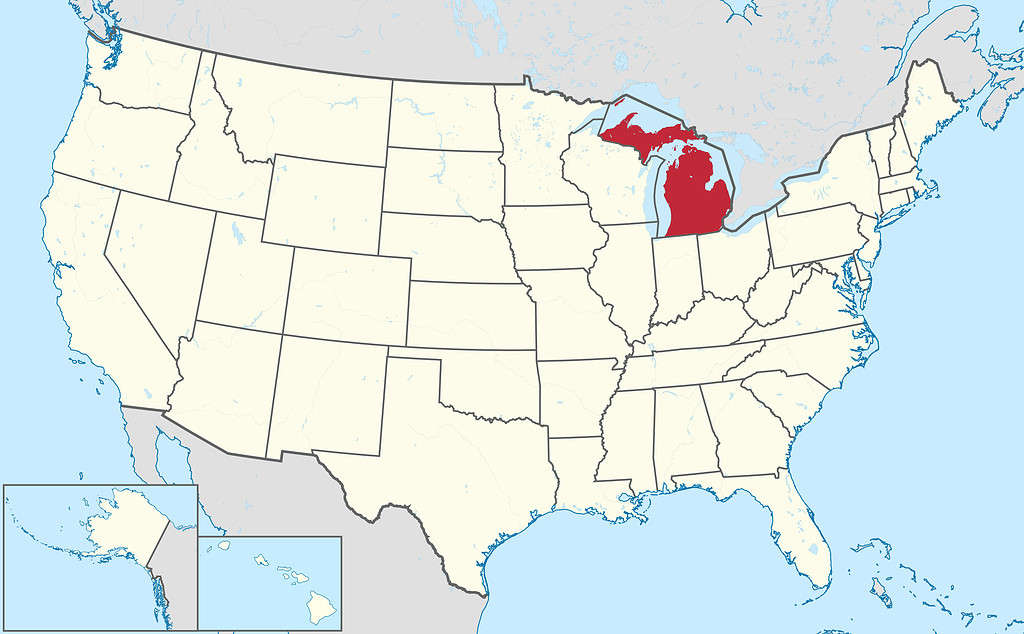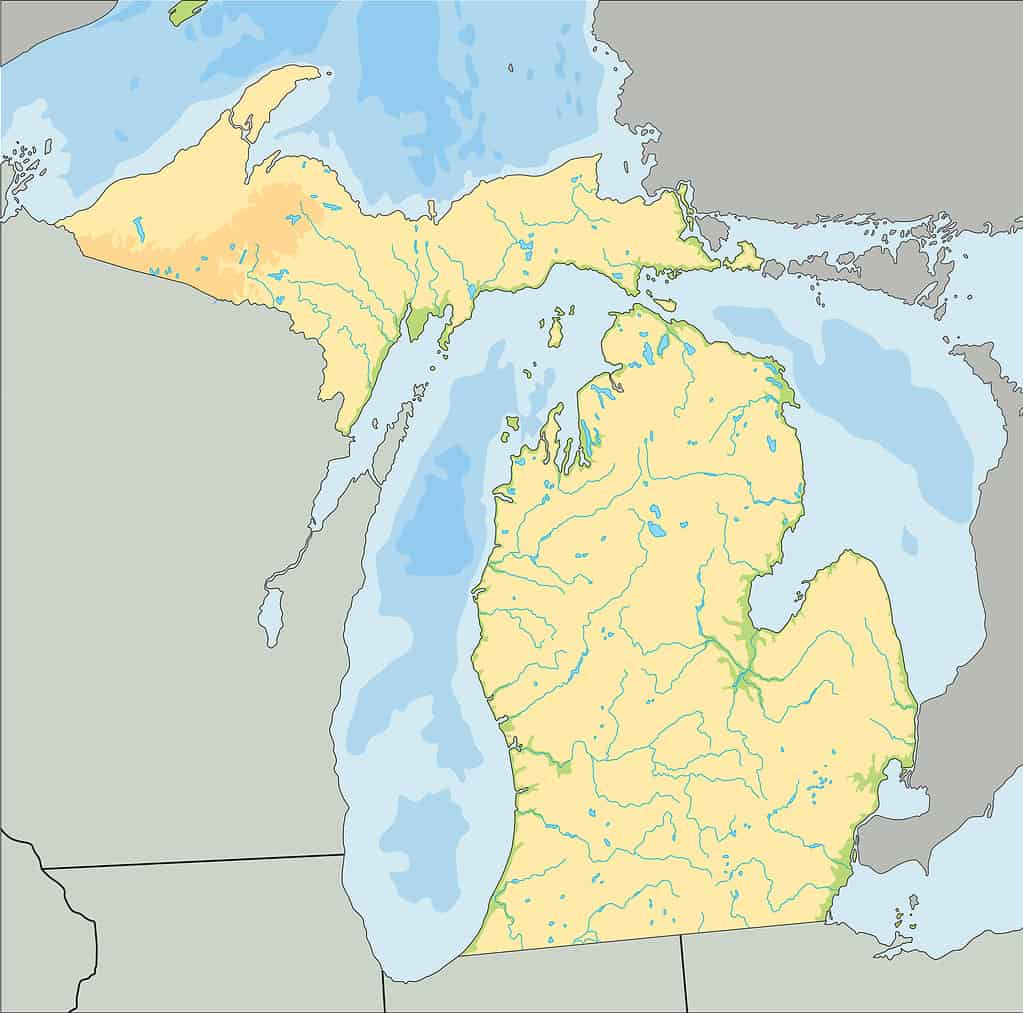Michigan is located in the Upper Midwest of the United States. It is the eleventh-largest state in terms of total area and the tenth-most populous state in the nation. Here is a look at Michigan’s location, history, climate, and more.
The Great Lakes Region
Michigan is part of the Great Lakes region in North America. The region encompasses parts of eight U.S. states. Along with Michigan, the states of the Great Lakes region include New York, Pennsylvania, Ohio, Indiana, Illinois, Wisconsin, and Minnesota. The region also includes most of the Canadian province of Ontario.
Detroit in southeastern Michigan is the third largest city in the Great Lakes region, behind Chicago and Toronto.
Which States Border Michigan?
Michigan borders five U.S. states. It shares land borders with Ohio and Indiana to the south and Wisconsin to the northwest. The state’s border with Minnesota lies in western Lake Superior and the border with Illinois lies in southern Lake Michigan.

Michigan borders five U.S. states and Ontario, Canada.
©TUBS / CC BY-SA 3.0 – License
International Boundary
Michigan shares an international border with Canada. The Michigan/Canada border is made up entirely of water. The boundary runs through Lake Superior, Lake Huron, and Lake Erie. Some of the boundary is marked by rivers, such as the St. Marys and St. Clair Rivers.
The U.S.-Canadian border is the longest international boundary in the world, spanning 5,525 miles (8,891 kilometers). Michigan’s share of that border stretches for 721 miles (1,160 kilometers), accounting for thirteen percent of the total U.S.-Canada boundary. Along with Michigan, twelve other U.S. states border Canada: Maine, New Hampshire, Vermont, New York, Pennsylvania, Ohio, Minnesota, North Dakota, Montana, Idaho, Washington, and Alaska.
Michigan’s Peninsulas
Michigan is the only state in the U.S. comprised of two peninsulas. The state’s motto is Si Quaeris Peninsulam Amoenam Circumspice, which translates to, “If you seek a pleasant peninsula, look about you.” This welcoming message is displayed on Michigan’s state seal.
Michigan’s two peninsulas are surrounded by four of the Great Lakes. Lake Ontario is the one Great Lake that does not connect with the state. Michigan is the only state that touches four of the five Great Lakes.

Michigan is the only U.S. state made up of two peninsulas.
©BardoczPeter/iStock via Getty Images
The two peninsulas are known as the Upper and Lower Peninsulas. Lake Superior bounds the Upper Peninsula to the north and Lake Michigan to the south. The Lower Peninsula (also known as The Mitten due to its mitten-like appearance on a map) is bounded by Lake Michigan to the west and northwest, Lake Huron to the northeast and east, and Lake Erie to the southeast.
Michigan’s two peninsulas are separated from each other by the Straits of Mackinac.
When Did Michigan Officially Join the U.S.?
Prior to the arrival of Europeans, the area that would later become the state of Michigan was inhabited by an estimated 15,000 Native Americans. Some of the tribes included the Chippewa (Ojibway), Ottawa, Potawatomi, Huron (or Wyandot), Sauk, Miami, and Menominee.
The first Europeans to arrive in Michigan were French explorers in the seventeenth century. France relinquished control of the region to Britain in 1762 following its defeat in the French and Indian War. Britain would control the territory until it ceded it to the United States after the American Revolution.
Michigan’s status remained in flux prior to its admittance as a state. It was part of the Northwest Territory. The western part of the state was later included in the Indiana Territory. The Michigan Territory was then formed in 1805.
Michigan’s admission as a state was delayed due to a conflict with Ohio over the Toledo Strip, a 468-square-mile area on the Michigan-Ohio border. Each state claimed to own the land. The tensions led to legislative actions on both sides. When that didn’t end the conflict, militias were positioned on each bank of the Maumee River. A few shots were fired, but there were no casualties. The bloodless conflict came to be known as the Toledo War.
Under pressure from the federal government, and specifically President Andrew Jackson, Michigan eventually gave up its claim to Toledo. In return, Michigan received much of the Upper Peninsula. After this agreement was finally reached, Michigan was admitted to the Union on January 26, 1837, becoming the twenty-sixth state.
Michigan was admitted as a free state. The Civil War would begin just twenty-four years after Michigan achieved statehood.
What Is the Climate in Michigan?
Michigan features a continental climate according to the Köppen climate classification scheme. It is subdivided further into two distinct regions.

Michigan lies in the Dfa and Dfb subcategories of the Köppen continental climate classification.
©Icy98 / CC BY-SA 4.0 – License
Southern and central parts of the Lower Peninsula have a DFA classification, meaning this region features hot summer days that can exceed 100°F. Humidity is also higher in this region during the summer.
The remainder of the state has a Dfb classification, which features cooler summers with less humidity.
Michigan averages 30–38 inches of precipitation annually, though the actual amount varies widely throughout the state. For example, Sault Ste. Marie receives over 120 inches of snowfall each year. Marquette receives even more snow, averaging over 190 inches per year.
The average temperatures in Detroit range from a high of 32°F in January to 85°F in July. The average temperatures for those same months in Sault Ste. Marie is 23°F and 75°F.
What Is Michigan Most Known For?
Lakes
Michigan is primarily known for its lakes. As noted earlier, it is the only state that touches four of the five Great Lakes. No other state borders more than two Great Lakes. Along with the Great Lakes, Michigan features nearly 65,000 inland lakes and ponds, including more than 10,000 lakes with areas of five acres or more. No point in Michigan is more than six miles from an inland lake. There is also no point in Michigan that is more than 85 miles from one of the Great Lakes. Michigan has the second-highest total water area in the nation, trailing only Alaska.
Winter
Many consider winter a time of drear, but Michiganders celebrate the season with a wide variety of winter activities, such as skiing, snowboarding, snowmobiling, snowshoeing, ice skating, ice fishing, and much more. Winter is about more than fun, though. It also represents big business. Winter activities pump over $3 billion into the Michigan economy each year. For example, Michigan has 47 ski areas. The only state with more ski resorts is New York.
In a state with so many lakes and so many winter opportunities, it’s only natural that it be recognized. The Michigan Secretary of State recently released the “Water-Winter Wonderland” license plate. The plate celebrates these natural wonders that are so central to Michigan’s identity. The new license plate is actually a re-release of an old plate. The plate was used in Michigan from 1965-1968.

Cross-country skiing is popular in northern Michigan.
©Christopher Tipton/Shutterstock.com
Islands
In a state with so much water, it’s not surprising that it is known for its many islands. Some of the most well-known Michigan islands include Mackinac Island, Isle Royale, Beaver Island, Drummond Island, and Charity Island.
Automotive Industry
Michigan is so linked to the auto industry that Detroit, the state’s largest city, is known as The Motor City. The “Big Three” automakers are all headquartered in Detroit: General Motors, Ford Motor Company, and Stellantis North America (formerly the Chrysler Corporation). Though these three are no longer world leaders in automobile manufacturing, they are still integral to Michigan’s culture and economy.
Lighthouses
Michigan is known as the Lighthouse Capital of the World. There are over 115 lighthouses in the state, many of which are found on the shores of the Great Lakes. Many of these lighthouses are open to the public and offer wonderful views and photo opportunities along Michigan’s lakeshores.

Michigan is home to spectacular lighthouses, such as the North Breakwater Lighthouse in Ludington.
©NOAA Great Lakes Environmental Research Laboratory / CC BY-SA 2.0 – License
Music
The music scene in Michigan is always vibrant. There are concert venues in virtually every city, and big-name acts always seem to add Michigan to their tours. However, the state is perhaps best known as the birthplace of Motown. Motown Record Corporation was founded in Detroit in 1959 by Berry Gordy, Jr. It became one of the most successful Black-owned businesses in American history. The label gave rise to the popularity of the specific type of soul music that it created. Some of Motown’s most famous artists include The Four Tops, Gladys Knight and the Pips, The Isley Brothers, The Jackson 5, Marvin Gaye, The Temptations, Stevie Wonder, and The Supremes.
Food
Michigan is famous for its coney dogs. Though they may be more connected with Coney Island in New York (hence the name), these dogs were created in Detroit. A classic Michigan coney dog features a hot dog topped with chili, diced white onions, and yellow mustard on a warm bun.
Detroit-style pizza is a deep-dish pizza that features a crust that is crunchy on the outside and soft on the inside. The cheese and sauce cover the crust, meaning every bite is packed with flavor!
Pasties are ubiquitous in the Upper Peninsula, but the dish can also be found throughout the state. If you order one, though, make sure you say it correctly. It is pronounced using the ă sound as in “past,” not the ā sound as in “paste.” Once you learn to pronounce it, you’re ready to enjoy this northern Michigan staple. A pasty features a doughy exterior with a crisp shell wrapped around fillings of beef, pork, or chicken. Other ingredients can include potatoes and root vegetables.

Pasties are a staple in Michigan’s Upper Peninsula, such as this one purchased in Munising.
©Bobak Ha’Eri / CC BY-SA 2.5 – License
Is Michigan a Good Place to Live?
Michigan is home to 10,034,113 residents (2022 U.S. Census Bureau estimate), placing it in the top ten most populous states in the U.S. With over ten million people who choose to make their home in Michigan, the state clearly has a lot to offer!
While this is nowhere near an exhaustive list, some of the best parts of living in Michigan include:
- Top-notch outdoor recreation opportunities all year long, as noted earlier.
- The Midwest hospitality of the state is seen virtually anywhere you go.
- The cost of living is relatively low.
- Sports fans have many teams to root for. Some of the state’s biggest teams include the Detroit Lions (National Football League), Detroit Pistons (National Basketball Association), Detroit Red Wings (National Hockey League), Detroit Tigers (Major League Baseball), the University of Michigan Wolverines, and the Michigan State Spartans.
- The weather is much calmer than in other parts of the U.S. Natural disasters are relatively rare throughout the year.
- It is a great place to escape summer’s oppressive heat and humidity, especially further north.
Of course, no state is perfect. There are downsides to living anywhere.
- While Michigan often avoids severe spring and summer storms, the winters can be brutally cold and snowy. If you don’t want to measure snow in feet, then much of northern Michigan may not be for you.
- Mosquitoes and biting flies can be bothersome. In parts of the Upper Peninsula, black fly invasions can sometimes reach near biblical proportions.
- The roads in Michigan are notoriously bad, largely due to the damage sustained in the long winter.
- Detroit is consistently ranked as one of the most dangerous cities in the United States.
The photo featured at the top of this post is © Alexander Lukatskiy/Shutterstock.com
Thank you for reading! Have some feedback for us? Contact the AZ Animals editorial team.






